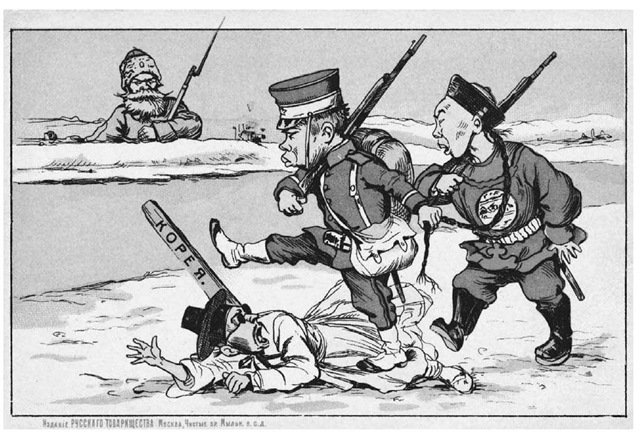The Russo-Japanese War (1904-1905) was the struggle between the two dominant nations in northeastern Asia for supremacy in Korea and Manchuria (a region in northeastern China bordering Russia and Mongolia). Russia had begun its expansion into Siberia in the sixteenth century. Its first border conflicts with China were solved via the treaties of Nerchinsk (1689) and Kyakhta (1727). During the eighteenth century, Russia built an empire reaching as far as Alaska, and during the nineteenth century, Russia intensified its empire-building efforts in East Asia. In 1858 China ceded the Amur region to Russia, and in 1860 China further surrendered parts of the coast, where in the same year the Russians established a naval base with the programmatic name Vladivostok (”ruler of the east”).
Japan Tramples Korea. In this illustrated postcard, printed in Russia around 1905, Japanese soldiers heading toward Russia march over a prostrate Korean man.
After the Japanese victory in the Sino-Japanese War (1894-1895), Russian and Japanese interests started to collide. When Japan demanded control of the strategically important harbor of LUshun (Port Arthur) on China’s Liaodong Peninsula, Russia combined forces with Germany and France and forced Japan to back down. Russia then took the harbor for itself in 1898. At the same time, Russia acquired the rights to build railways through Manchuria, providing a vital connection to Vladivostok and the new base at Port Arthur.
Under the pretext of aiding besieged legations in Beijing during the Boxer Uprising of 1900, Russia sent considerable reinforcements into Manchuria. In addition, Russia became interested in extending its influence into Korea, an area that Japan regarded as a potential future colony. Japan and Russia thus failed to reach an agreement on their mutual interests, causing Japan in 1903 to consider going to war. On February 4, 1904, Japan broke diplomatic relations with Russia.
Hostilities commenced without a declaration of war on the night of February 8, 1904, when Japan launched a torpedo boat attack on the Russian fleet at Port Arthur.
At the same time, the Japanese fleet under Admiral Heihachiro Togo (1847-1934) was on its way to blockade Russian harbors and secure landing operations for the Japanese army on the Korean Peninsula.
Several indecisive naval engagements ensued. At first, the Russian fleet mainly stayed near the coastal batteries at Port Arthur. A brief period of greater Russian activity under Admiral Stepan Osipovich Makarov (1849-1904) ended with the admiral’s death when his flagship, Petropavlovsk, struck a mine on April 13, 1904. Meanwhile, the Japanese blockade gave their army cover for landing operations in Korea. Japanese forces occupied Korea in February and March 1904, and by the end of April, Japanese troops started to cross the Yalu River into Manchuria.
On May 1, 1904, Russia was defeated in the Battle of the Yalu. Japan combined the advance into Manchuria with further landings on the Manchurian coast, and the Russians were forced to fall back. Russia was thus cut off from Port Arthur, which came under siege from Japan. In August, the Russian fleet attempted to break through to Vladivostok, but was defeated by Togo’s forces in the Battle of the Yellow Sea (August 10). Russia’s relief operations failed, and after the Battle of Liaoyang (August 26-September 3), Russian land forces were forced to fall back on Shenyang (Mukden).
After several attempts resulting in high numbers of Japanese casualties, Port Arthur fell to the Japanese on January 2, 1905. The Russians had originally counted on gaining the upper hand with the arrival of reinforcements via the Trans-Siberian Railway, but the connection was too slow and the Russian forces were continually driven back. After victory in the Battle of Mukden (February 19-March 10, 1905), Japanese forces gained the upper hand in Manchuria.
Russia had earlier dispatched its Baltic fleet under Admiral Zinovy Petrovich Rozhestvensky (1848-1909) to relieve Port Arthur. After a long journey around the Cape of Good Hope, the fleet was intercepted by Japan in the Tsushima Strait and was almost annihilated in the Battle of Tsushima (May 27-28, 1905).
Peace between Japan and Russia was negotiated by U.S. President Theodore Roosevelt (1858-1919), and on September 5, 1905, the Treaty of Portsmouth was concluded. Russia ceded Port Arthur and the Liaodong Peninsula to Japan and recognized Korea as a Japanese sphere of influence. Russia’s disastrous defeat in the Russo-Japanese War led to the Russian revolution of 1905. After the war, Russia withdrew from the power struggle in East Asia and concentrated on inner reforms and the reconstruction of its military. This first major victory of an Asian power over a Western one came as a surprise. The Japanese success inspired resistance against Western imperialism in all of Asia, and especially in China. Without Russian competition, Japan rapidly expanded its sphere of influence, a development that eventually culminated in World War II in the Pacific.

